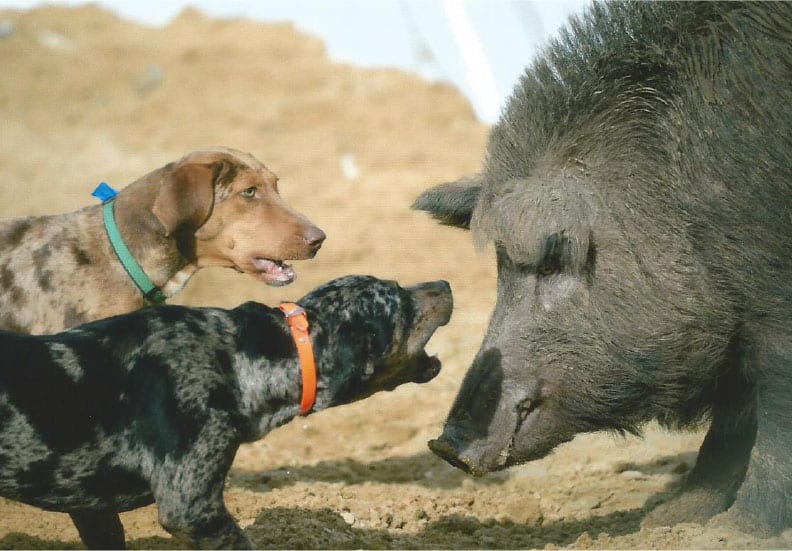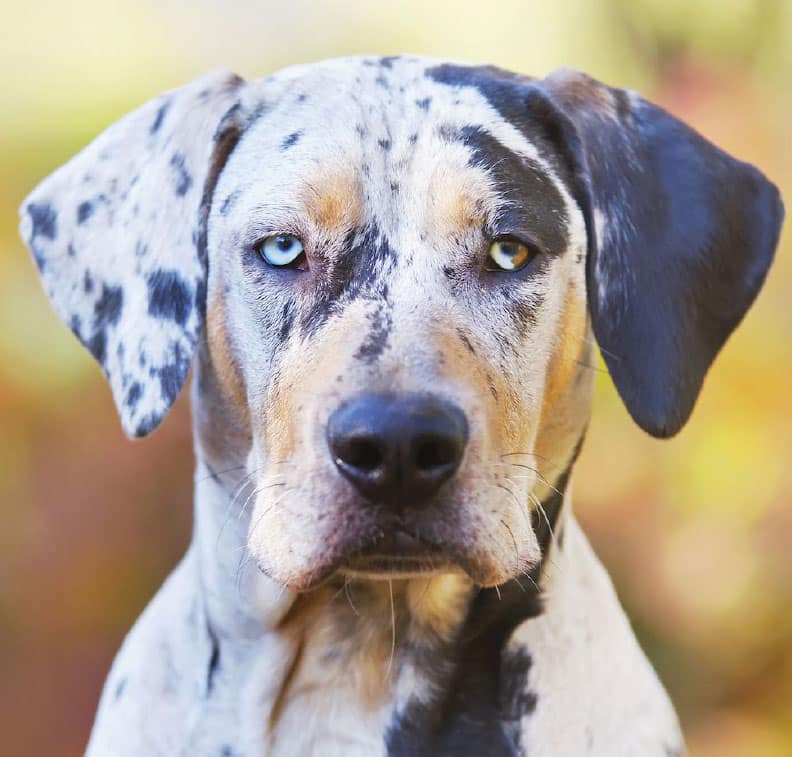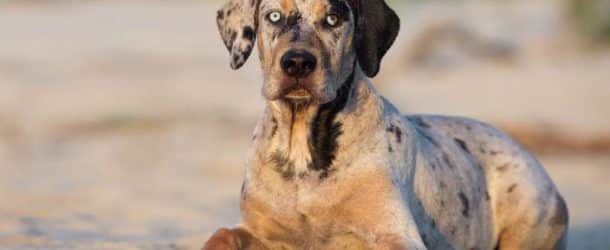Louisiana’s State Dog, The Catahoula Leopard Dog, Is A True Jack Of All Trades
By Karla Wall
The Catahoula Leopard Dog — also known as the Catahoula cur, the Catahoula hound, the Catahoula hog dog or simply the Catahoula dog — has long been a favorite partner for hunters in this region. One of the reasons for their popularity is the breed’s versatility as a hunter.
“You can go squirrel hunting with them during the day, and coon hunting with them at night,” says Renee Jackson, former president and founder of the Working Catahoula Dog Association.
That’s in addition to hunting wild boar.
But Catahoula dogs are much more than hunting dogs. They also work cattle and are excellent guard dogs with a strong instinct to protect their home and family.
“They’re just a good all-around dog,” says Warren Manuel, who’s been breeding Catahoula dogs since 1979.
“You can use these dogs for anything,” says Jackson. “They’re one of the few breeds that can do anything.”
Coats Of Many Colors
The Catahoula dog is a striking medium-size dog; while they’re not huge, seeing these dogs brings one word to mind: power. Their sleek, short-haired bodies are well-muscled and sturdy. Their heads can resemble those of a great Dane or Mastiff or can look more slender and hound-like.
Adult males can weigh up to just over 100 pounds. Males can be 22 to 23 inches in height, and females 20 to 24.
They can come in many colors, ranging from black to brindle (black base interspersed with lighter hairs or vice-versa), red merle, blue merle, red, yellow, even white. Eye color can range from dark brown to a clear ice-blue color called a “glass eye.”
A Rather Diverse Background
That range in color and appearance is due to the breed’s fascinating background, which revolves around the Catahoula Lake area in Central Louisiana.

“Mastiffs were purebred, and at that time, in that country, only royalty could own purebred dogs. They weren’t used as war dogs,” says Jackson, a multi-generation Catahoula breeder of Jena Choctaw descent.
Rather, says Jackson, it was a powerful multi-purpose Spanish dog called the Alano Espanol that DeSoto and his soldiers brought with them.
Looking at today’s Catahoula dogs, you’ll also notice some sighthound (greyhound-type dogs) in the breed. And, says Jackson, there were some sighthound dogs with DeSoto that contributed to the breed.
The dogs that resulted from those breedings were later bred to French dogs called beaucerons, all-purpose farm and ranch dogs brought to Central Louisiana by the French explorers who settled the Natchitoches area in the 1700s. The beaucerons, says Manuel, are responsible for the blue “glass eyes” of today’s Catahoula dogs.
The breedings that ultimately produced the Catahoula dog weren’t carefully planned or thought out, says Jackson.
“It was happenstance,” she says. “People romanticize it and say Native Americans took in these poor lost dogs left behind by the soldiers and bred them to their dogs, but that wouldn’t have happened. The crosses happened by accident.”
Nevertheless, the Choctaw of Central Louisiana began using the dogs that resulted from these breedings to drive hogs and cattle from Catahoula Lake to Natchitoches, says Jackson.
The dogs became a fixture in the region, and “by the 1900s, most settlers in (Central Louisiana) had a Catahoula,” says Jackson.
Earning Their Keep
And there’s a reason for that. The Catahoula dog is truly a do-it-all companion.
They’re a hunting dog, as stated earlier; they’re a treeing breed, meaning they can chase small game such as racoons and squirrels into trees and keep them there to await their human hunting partners.

They’re farm and ranch dogs extraordinaire, more than able to perform a variety of tasks, from driving cattle to protecting them.
Manuel says he recently sold one of his Catahoula dogs to the famous King Ranch in South Texas, where the dog used to work cattle in mesquite thickets.
“They don’t take just any dog,” Manuel says. “They want a dog that will work.”
“Owning a good Catahoula dog is like having an extra right hand,” says Jackson. She relates a story that illustrates just how seriously Catahoula dogs take their work.
During an extremely powerful thunderstorm, a dead tree was uprooted and fell onto the hog pens next to it.
“I heard one of my dogs — a male — barking and barking,” Jackson recalls. “My husband wouldn’t let me go out in the storm to see what was going on. The weather was that bad. When the weather broke the next morning, I went out to see about the dog, and discovered that the pen had been destroyed.”
The hogs, she says, were still in place, kept there by her dog — who’d been on the job all night.
“I was just amazed at the heart of this dog,” she says. “I’m still in awe.”
They’re also a staunch protector of property and family, says Manuel.
“If I’m not at home, they won’t let anyone in the yard,” he says. “If I am home, and just stand back when someone comes to the gate, the dogs won’t let them open it. I have people call when they want to come over and tell me to put the dogs up.”
Manuel says he’s sold a dog to an Austin, Texas, police officer as a guard dog for the officer’s children.
“These dogs will protect a kid no matter what, from any animal or human,” he says. “One of my grandsons would walk in his sleep when he was a child,” Manuel says. “One of my female (Catahoula dogs) would get up, lay on top of him and keep him from wandering off until morning.”
Jackson says she literally owes her life to a few of her dogs, one of which saved her when a female hog she and her husband had recently moved onto the property attacked her.
“This was the biggest, baddest sow I’d ever seen,” she says. “She’d been caught on a deer lease and we put her in a pen here on our property. She broke out of the pen and grabbed me on the side of my leg. I still have the scar.”
Jackson says one of her male dogs ran up and managed to separate the hog from her and keep it from continuing the attack.
Another dog, she says, prevented her from stepping on a water moccasin.
“It stopped in front of me, kept ‘huffing,’ and would not let me move. I couldn’t understand why.”
Someone behind her told her that there was a snake in front of her that she’d failed to see — her dog wasn’t about to let her step on it.
“They just have a primitive instinct to protect their home and people,” Jackson says.
They’re also becoming popular as search and rescue and blood trailing dogs, says Jackson. Truly a jack of all trades.
Not For Everyone
The Catahoula dog possesses the power, determination and energy to perform almost any function, and that’s made it an incredibly popular dog among ranchers and hunters, first in Central Louisiana and now pretty much all over the world.
“The popularity of the Catahoula dog is soaring,” says Manuel. “People are buying them to work cows in Australia, Germany, Russia, England, Yugoslavia and Sweden. A lot of Slavic countries have introduced Catahoulas.”
But not everyone needs or is equipped to handle that kind of drive and focus. They’re not for everyone.
They’re a working dog, and need a job to do, says Jackson. If you don’t give them one, they will find one. And you won’t necessarily like what they find to do.
“They’ll eat your couch if they have nothing to do,” says Jackson, who has a two-year waiting list for her puppies. “The only good Catahoula dog is a tired one.”
“They’re not a dog that can sit in the house all day,” says Manuel. “They need a yard they can run in and a good fence. A Catahoula dog will jump a five-foot fence just for fun.”
Jackson relates the story of coming home and finding a dog on her roof.
“She had climbed out of her run, across the top of another run and onto the roof,” she says. The dog was bored and wanted an adventure.
Catahoula dogs are very easily trained, says Jackson. “By the time they’re 10 to 12 years old, you don’t even need to say anything to them; they know what you want and just do it.”
They’re extremely intelligent — they have to be. And anyone who wants to successfully own one of these dogs has to be even smarter.
“You have to be smarter than they are,” Jackson says.
You also have to be dedicated to training them. But Jackson cautions that Catahoula dogs aren’t like most breeds that are thought to be highly trainable.
“A Catahoula dog will take the training and utilize it when it’s necessary and ignore it when it isn’t. And they know the difference,” Jackson says.
Yet another story from Jackson, who’s accumulated many of them from a lifetime with these dogs, illustrates the point.
“I had a dog that was working cows. She wouldn’t come when I called her off. She wouldn’t obey me,” she says. “I went to see why and found that a cow had stepped into the fence and was trying to go through. The dog had her tailed and was keeping her from going through.”
When not in the field or on the farm, Catahoulas utilize their training in organized competitions. The Working Catahoula Association competition in Jena, La., took place just a couple of weeks ago. The five-night competition features treeing contests, hog roundups, trailing contests and cattle working trials. Some Catahoula owners, says Manuel, compete in United Kennel Club obedience competitions, particularly in the Kentucky and Tennessee areas.
And the National Association of Louisiana Catahoulas holds five or six competitions throughout the year between Baton Rouge and New Orleans.
Both Jackson and Manuel say what drew them to the breed was its history, versatility and personality.
“They’re just a great all-around dog,” says Manuel.
“I love their grit, their strength and their heart,” says Jackson.
















Comments are closed.